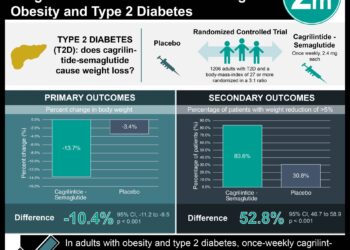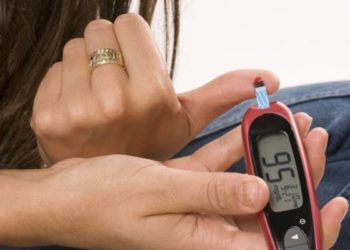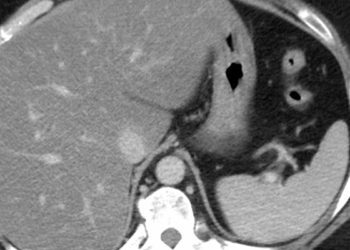Continuous glucose monitoring improves glycemic control in adolescents and young adults with Type 1 Diabetes.
1. Patients who used continuous glucose monitoring (CGM) showed significantly reduced glycated hemoglobin (HbA1C) levels compared to those who used standard blood glucose monitoring (BGM) after 26 weeks.
2. On average, patients in the CGM group spent more time in the target glucose range (70-180 mg/dL) compared to those in the BGM group.
Evidence Rating Level: 1 (Excellent)
Study Rundown: Effective management of glucose levels is still a challenge for many patients with type 1 diabetes (T1D). The traditional BGM system involving a finger prick is unpleasant for many, and thus interferes with compliance. With the recent advancements in CGM technology, studies comparing glycemic control outcomes between these two interventions are warranted. While such studies have begun in adults, the data on adolescents and young adults is still lacking. In this randomized clinical trial, the effects of CGM and BGM on glycemic control were evaluated in a population of adolescents and young adults. Findings suggest that patients who used CGM exhibited reduced HbA1C levels and spent more time in target glucose ranges compared to patients who used the standard BGM method. Additionally, patients who used CGM self-reported a significantly higher satisfaction rating with their monitoring method compared to those in the BGM group. However, clinicians responsible for providing patients with treatment recommendations were not blind to the treatment assignments. While necessary for proper patient care, this leaves room for potential bias. Nonetheless, this study was strengthened by its high follow-up rate and randomization of groups with comparable sex and ethnic representation.
Click to read the study, published today in JAMA
Relevant Reading: Continuous Glucose Monitoring in People With Type 1 Diabetes on Multiple-Dose Injection Therapy: The Relationship Between Glycemic Control and Hypoglycemia
In-Depth [randomized controlled trial]: In this randomized clinical trial, 153 participants between ages 14 and 24 years were recruited from 14 endocrinology practices in the US between January 2018 and May 2019. Patients were enrolled if they met the following eligibility criteria: clinical diagnosis of T1D, 14 to 24 years of age, diabetes duration of at least one year prior, HbA1C between 7.5-11.0%, use of either insulin pump or multiple daily insulin injections, total daily insulin of at least 0.4 units/kg/d, and no use of real-time CGM for at least 3 months prior to study enrollment. Participants were randomized into either the CGM or BGM group for a total of 26 weeks. All study participants had in-clinic follow ups at 4, 7, 13, and 26 weeks and remote check-ins at 1, 2, and 19 weeks after randomization. The BGM group was required to use a CGM device for two weeks prior to the final 26-week visit, whereas the CGM group used the device throughout the study duration. The primary outcome measure was a change in HbA1C from baseline to the 26th week. Additionally, one of many secondary outcomes was the mean percentage of time spent in glucose target ranges. Patients who used CGM showed mean HbA1C levels of 8.9% and 8.5% at baseline and 26 weeks, respectively, while patients who used BGM report mean HbA1C levels of 8.9% at both baseline and after 26 weeks. The adjusted between-group difference was -0.37% (95% confidence interval [CI], -0.66% to -0.08%; P = 0.01). Additionally, patients who used CGM were observed to have a mean percentage time (%, hours/day) in target glucose range (70-180 mg/dL) of 37% at baseline and 43% after 26 weeks compared to 36% at baseline and 35% after 26 weeks in the BGM group (adjusted between-group difference, 6.9% [95% CI, 3.1% to 10.7%]; P < 0.001). In summary, adolescents and young adults who used the CGM method showed modest reductions in HbA1C compared to those who used standard BGM after a 26 week period.
Image: PD
©2020 2 Minute Medicine, Inc. All rights reserved. No works may be reproduced without expressed written consent from 2 Minute Medicine, Inc. Inquire about licensing here. No article should be construed as medical advice and is not intended as such by the authors or by 2 Minute Medicine, Inc.







